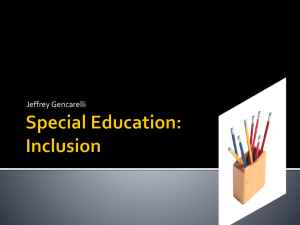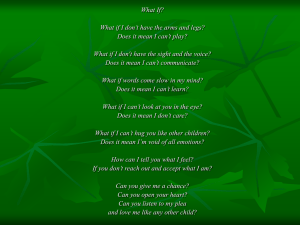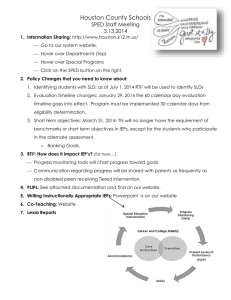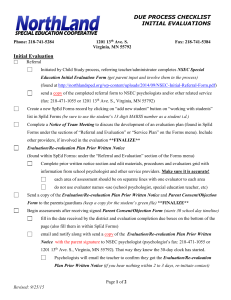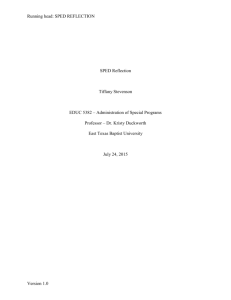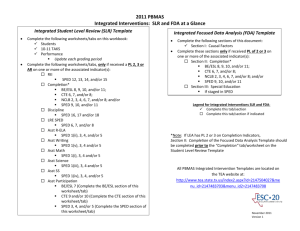Special Education - East Carolina University
advertisement
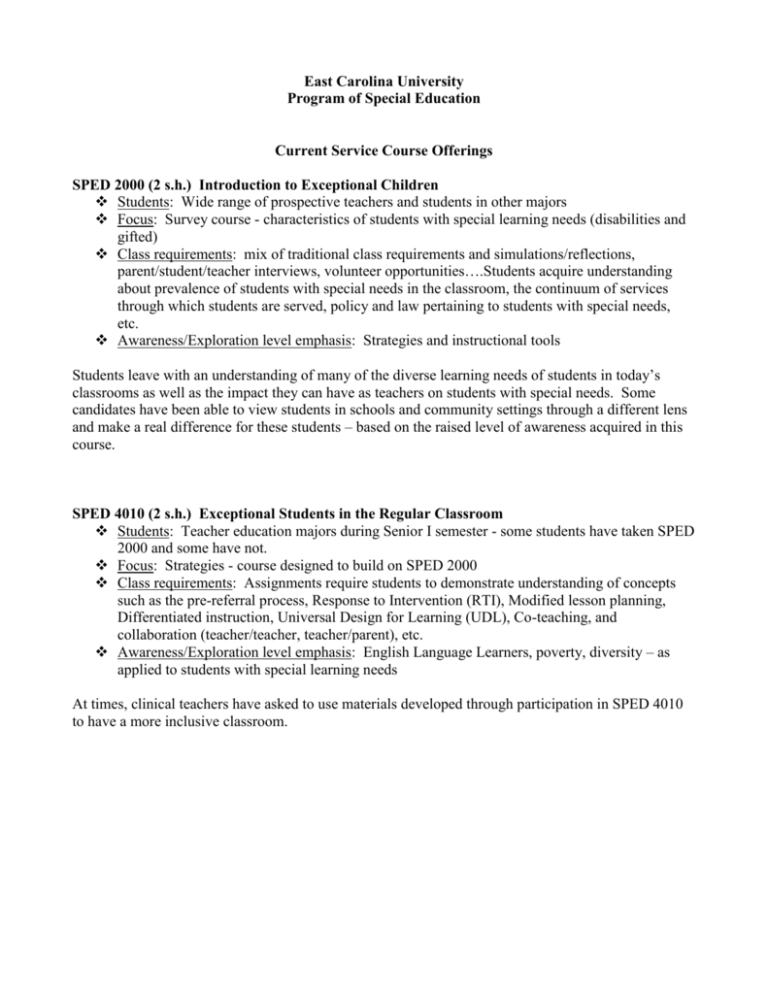
East Carolina University Program of Special Education Current Service Course Offerings SPED 2000 (2 s.h.) Introduction to Exceptional Children Students: Wide range of prospective teachers and students in other majors Focus: Survey course - characteristics of students with special learning needs (disabilities and gifted) Class requirements: mix of traditional class requirements and simulations/reflections, parent/student/teacher interviews, volunteer opportunities….Students acquire understanding about prevalence of students with special needs in the classroom, the continuum of services through which students are served, policy and law pertaining to students with special needs, etc. Awareness/Exploration level emphasis: Strategies and instructional tools Students leave with an understanding of many of the diverse learning needs of students in today’s classrooms as well as the impact they can have as teachers on students with special needs. Some candidates have been able to view students in schools and community settings through a different lens and make a real difference for these students – based on the raised level of awareness acquired in this course. SPED 4010 (2 s.h.) Exceptional Students in the Regular Classroom Students: Teacher education majors during Senior I semester - some students have taken SPED 2000 and some have not. Focus: Strategies - course designed to build on SPED 2000 Class requirements: Assignments require students to demonstrate understanding of concepts such as the pre-referral process, Response to Intervention (RTI), Modified lesson planning, Differentiated instruction, Universal Design for Learning (UDL), Co-teaching, and collaboration (teacher/teacher, teacher/parent), etc. Awareness/Exploration level emphasis: English Language Learners, poverty, diversity – as applied to students with special learning needs At times, clinical teachers have asked to use materials developed through participation in SPED 4010 to have a more inclusive classroom. New NCDPI Rubric Indicators Potentially Addressed in a Special Education Course Standard 1 Teachers Demonstrate Leadership Uses data driven instruction (1a) throughout all classroom activities (e.g. IEP process, individualized instruction with decisions based on individual student data, use of a range of summative and formative data) Takes responsibility for the progress of students (1a) and participates in professional learning community (1b) by demonstrating leadership in the classroom and schools, advocating for students with special needs, leadership in collaborative and consultative relationships, etc. Demonstrates ethical behavior (1e) in accordance with positive dispositions, policy, law and confidentiality as they relate to students with special needs Standard 2 Teachers Establish a Respectful Environment for a Diverse Population of Students Communicates high expectations for all students (2c) Collaborates with specialists who can support the learning needs of students (2d) Provides unique learning opportunities such as inclusion and researchbased effective practices for students with special needs (2d) Teachers Facilitate Learning for their Students Understands developmental levels of students and appropriately differentiates instruction (4a) Assesses resources needed to address strengths and weaknesses of students (4a) Uses a variety of data for short and long range planning of instruction. Monitors and modifies instructional plans to enhance student learning (4b) Demonstrates awareness or use of appropriate methods and materials necessary to meet the needs of all students (4c) Communicates clearly with students in a variety of ways (4e) Uses multiple indicators, both formative and summative, to monitor and evaluate student progress and to inform instruction (4h) Teachers Analyze Student Learning Provides ideas about what can be done to improve student learning in their classroom (5a) Considers and uses a variety of research-based approaches to improve teaching and learning (5c) Standard 4 Standard 5 Five Potential Delivery Options (Ideas to begin conversations) A. Option A: SPED 2000 and 4010 delivered in their current format: This would involve retaining and possibly modifying the two distinct courses at 2 or 3 credit hours each. However, for indicators to be covered in the manner described below, the SPED 4010 standards must build on groundwork already established in SPED 2000. Students would not benefit from taking SPED 4010 without first having SPED 2000. SPED 2000 (Potential Indicators Addressed) Standard 1: Teachers Demonstrate Leadership Demonstrates ethical behavior (1e) in accordance with positive dispositions, policy, law and confidentiality as they relate to students with special needs Standard 2: Teachers Establish a Respectful Environment for a Diverse Population of Students Communicates high expectations for all students (2c) Collaborates with specialists who can support the learning needs of students (2d) Standard 4: Teachers Facilitate Learning for their Students Understands developmental levels of students and appropriately differentiates instruction (4a) Standard 5: Teachers Analyze Student Learning Provides ideas about what can be done to improve student learning in their classroom (5a) SPED 4010 (Potential Indicators Addressed – if students begin with competencies address in SPED 2000) Standard 1: Teachers Demonstrate Leadership Uses data driven instruction (1a) throughout all classroom activities (e.g. IEP process, individualized instruction with decisions based on individual student data, use of a range of summative and formative data) Takes responsibility for the progress of students (1a) and participates in professional learning community (1b) by demonstrating leadership in the classroom and schools, advocating for students with special needs, leadership in collaborative and consultative relationships, etc. Standard 2: Teachers Establish a Respectful Environment for a Diverse Population of Students Communicates high expectations for all students (2c) Collaborates with specialists who can support the learning needs of students (2d) Provides unique learning opportunities such as inclusion and research-based effective practices for students with special needs (2d) Standard 4: Teachers Facilitate Learning for their Students Assesses resources needed to address strengths and weaknesses of students (4a) Uses a variety of data for short and long range planning of instruction. Monitors and modifies instructional plans to enhance student learning (4b) Demonstrates awareness or use of appropriate methods and materials necessary to meet the needs of all students (4c) Communicates clearly with students in a variety of ways (4e) Uses multiple indicators, both formative and summative, to monitor and evaluate student progress and to inform instruction (4h) Standard 5: Teachers Analyze Student Learning Considers and uses a variety of research-based approaches to improve teaching and learning (5c) B. Option B: Merge content of SPED 2000 and SPED 4010 into a new 3 hour course that addresses all the indicators listed above C. Option C: Either of the first two formats – designed for specific groups of students (e.g. elementary, middle grades, secondary, K-12, educational professionals who serve in similar school roles, etc) D. Option D: Teaching the SPED course linked with other content area courses, increasing the possibility of team teaching E. Option E: New format yet to be determined by collaboration with our colleagues

